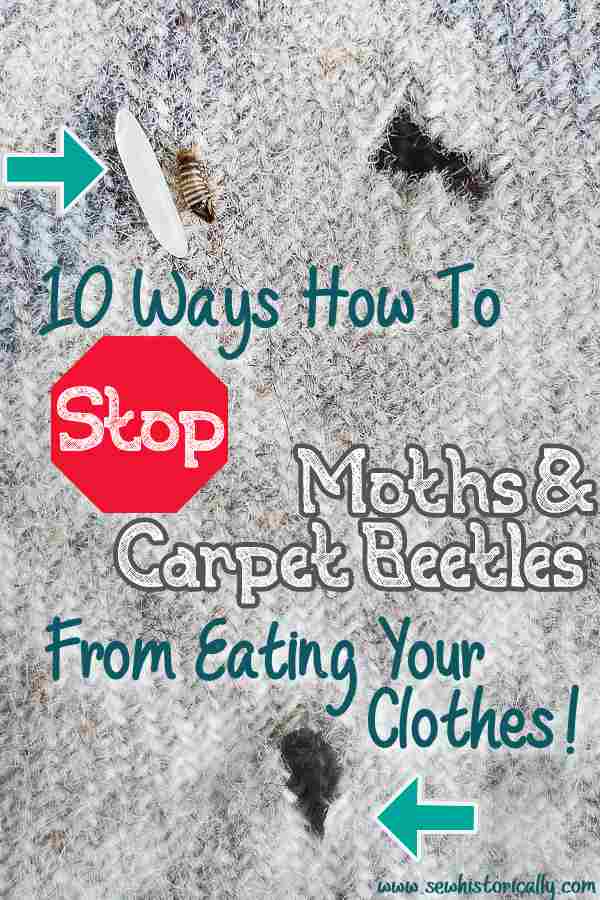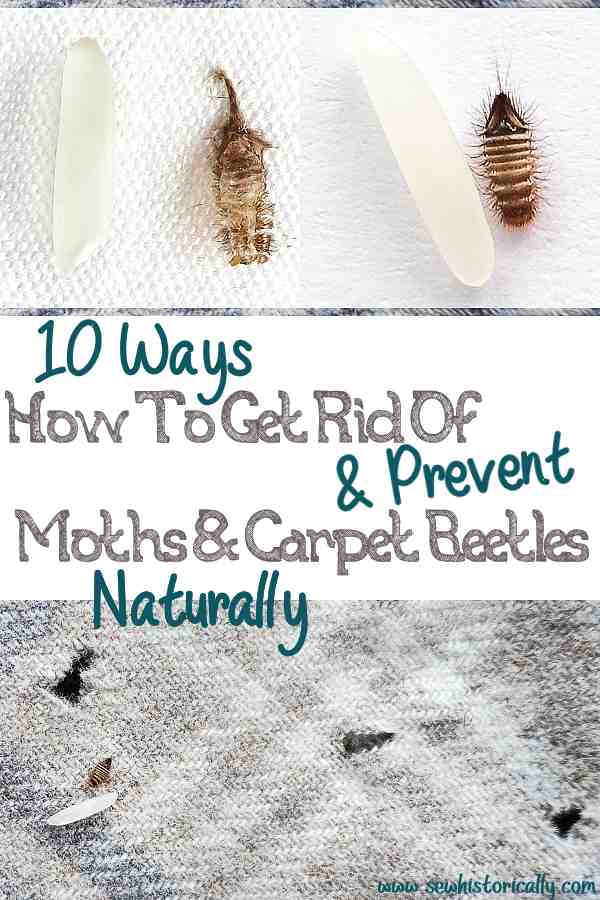How to prevent moths from eating clothes? How to get rid of moths and carpet beetles? Are you wondering how to store your expensive vintage and historical wool clothes to keep them save from moths? And how did the Victorians prevent moths damage to clothes and carpets? Find out how to prevent and get rid of moths and carpet beetles effectively and naturally!
If you find holes in your woolen clothes, you know you have a problem with fabric pests! There are two main insect species that damage woolen clothes: clothes moths and carpet beetles. The larvae of moths and carpet beetles eat irregular holes into wool clothes, especially in the summertime.
Clothes moths, as well as carpet beetles, can do serious damage to expensive and valuable historical wool clothes. Vintage clothing collectors, historical costumers or anyone who has woolen clothes in their closet, probably has to deal with moths and other fabric pest at some time. Wool was a popular fabric in days gone by because it’s warm and wears well. But moths and carpet beetles love to feed on protein-based fibers, such as wool! Therefore the Victorian knew many tips on how to prevent moths damage which you can still use effectively today!
‘Wool has its special danger from moths. The annual money loss in this country from destruction by moths has never been and can never be calculated, but every year in thousands of households such loss occurs.
This is not always due to carelessness, but often to lack of knowledge. The garment properly cleaned before it is put away and properly protected is safe from moths and other insects. It takes care and thought to accomplish this, but the money saved is income to the family.’ (Getting Your Money’s Worth. A Book On Expenditure, 1922)
Clothes Moths Or Carpet Beetles?
Do you know what’s bugging you? You probably will never see living moths or carpet beetles. If you see moths flying around, they aren’t clothes moths but rather pantry moths. Clothes moths don’t like light, so they’re only active in the dark and at night. However, there’s an easy way to tell whether moths or carpet beetles are eating your woolen clothes. Both eat irregular holes into woolen clothes but moths leave behind a silky webbing, while beetle larvae leave dried skins which look like fuzzy, striped brown rice grains (there’s a picture of a dried skin and a living carpet beetle with a rice grain for size comparison in the last photo of the post).
However, there are many species of carpet beetles and moths: Some of the most common fabric pests in homes are common carpet beetles (Anthrenus scrophulariae), fur beetles (Attagenus pellio), Australian carpet beetles (Anthrenocerus australis), museum nuisance beetles (Reesa vespulae), common clothes moths (Tineola bisselliella), case-bearing clothes moths (Tinea pellionella) and pale-backed clothes moths (Monopis crocicapitella). All these carpet beetles and moths can be found worldwide! If you want to know exactly what fabric pest are in your home, here’s a great pdf on how to identify the most common fabric pests by the Natural History Museum.
Animal-Based Vs. Vegetable Fibers
The larvae of moths and carpet beetles feed on woolen clothes. But they don’t only damage woolen clothes, they also damage other animal-based materials, such as feathers, down, fur, wool carpets and upholstered furniture. However, even though silk is also an animal-based materials, it’s less often attacked by moths or carpet beetles.
Moths and carpet beetles usually feed on animal – protein-based – fibers only, and not on vegetable or plant fibers. However, sometimes you even find holes in vegetable fibers – such as cotton or rayon – and even synthetic fibers – such as polyester – if they’re stored together with wool. So it’s better to store protein-based and vegetable fibers separately.
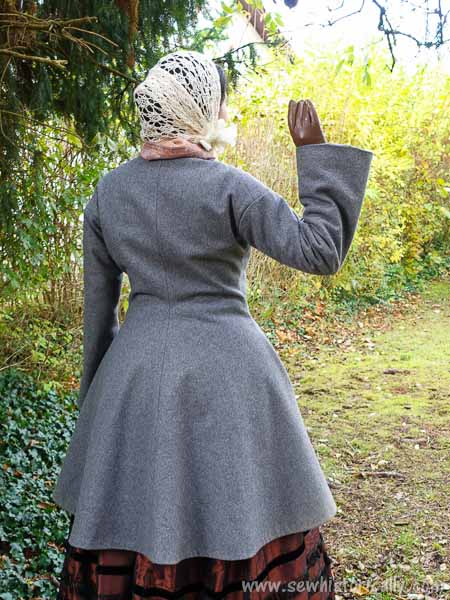
Is There Wool That Moths Don’t Like?
Moths and carpet beetles prefer soft, loose wool with a fuzzy surface – such as your precious angora sweaters. Heavy broadcloth winter coats are usually spared. So if you buy wool fabric or wool clothes, choose high quality wool fabric like broadcloth that was woven (instead of knitted) before felting, is heavily felted and has a smooth surface. Moths and carpet beetles usually don’t like this type of wool fabric.
Related: Victorian Gray Broadcloth Coat
Wash Or Brush Before Storing
Wash & Air Wool Clothes
Always wash woolen clothes before you store them. This simple step is very effective to get rid of moths and beetle eggs. It also removes the smell (food and perspiration stains) and skin particles which attracts moths and beetles. Even if the label of your wool clothing says dry-clean only, you can usually still wash it in the woolen cycle of your washing machine.
‘No soiled clothing should be put away, as dirt attracts moths and buffalo bugs. Even perspiration stains under the arms will often attract them. The clothing should, if possible, be hung out for a day in the air and sunlight before packing away.’ (A Bachelor’s Cupboard, 1906) ‘During the week before the “siege” of house-cleaning in spring or fall, look over all garments and articles to be put away, mend, remove all grease spots if possible […] and place on the line in the wind and sun for a day. Towards evening, before dampness finds its way into them, fold them up’ (Practical Housekeeping, 1887).
Brush Wool Clothes Instead Of Washing
If you prefer not to wash a woolen item, a coat for example, you can simply dry brush it outside to get rid of moths and beetle eggs. In the Edwardian era, wool skirts were never washed, instead they were brushed every day!
Related: Edwardian Plaid Wool Skirt
‘Take furs and other winter clothing, before the insidious miller claims them for its home; hang out doors in the wind, brush well with a whisk-broom’ (Three Meals A Day, 1902). ‘Furs […] should be combed carefully with a dressing-comb, beaten and aired (but not in the hot sun) […] Any article of fur, which has previously been troubled with moths, should be opened and examined in July, to make sure no moth is harbored in them, despite the precautions taken. This process, pursued resolutely year after year, will keep a house almost, if not entirely free, from the moth, and save much destruction and annoyance.’ (Practical Housekeeping, 1887)
Vacuum
And museums have another technique to clean valuable antique wool clothes. They simple vacuum the woolen clothes through a nylon mesh (stockings), cheesecloth or a fiberglass screen to remove dust and moths eggs. You can also use this for your modern woolen clothes. More about cleaning historical clothes at the V&A Museum.
How To Store Woolen Clothes
Woolen clothes should be stored in sealed bags. Today, you can store it in resealable plastic bags or plastic boxes. But in days gone by, woolen clothes were either wrapped in sturdy brown paper or sewn into cotton fabric. The packages were then often put into cedar chests which naturally repel moths.
For historical clothes, paper should be acid-free and the clothes shouldn’t come in direct contact with cedar wood. Because the acid in wood and paper can cause wool clothes to turn yellow, according to the North Caroline Museum Of History.
Brown Paper Bags Or Wrap In Newspaper
‘When winter clothes are put away for the summer, examine carefully, shake well, and wrap each article in paper and tie up securely. […] Blankets can be wrapped in old sheets or large papers.’ (Mrs. Owens’ Cook Book, 1903)
‘Take furs and other winter clothing […] and envelop in brown paper sacks. Wrap the more valuable articles in newspapers before putting in the sacks. Printers’ ink being one of the best preservatives against the depredations of moths.
Turn over the edges of the sack and paste carefully down with a little flour paste (raw flour and cold water stirred smoothly together will answer), making sure that there are no openings in the sack where the moth miller can creep in. This is absolutely safe if done early in the season.
Blankets, shawls, cloaks, etc., can be wrapped in large papers. Label every article as it is fastened, and keep a little memoranda book of where each package is put, that when one especial article is needed it can be found at once.’ (Three Meals A Day, 1902)
Fold wool clothes ‘up with pulverized camphor, cut tobacco or cedar chips, lay in their wrinkles, wrap them in newspaper, carefully tie and label them, and they are ready for the closet shelves.’ (Practical Housekeeping, 1887)
Linen Bags
Furs should be ‘wrapped in linen, sewed up, and then put in a paper bag. Newspaper is not strong enough; brown wrapping paper is better. Paper boxes may be used, but should be pasted securely so nothing can enter.’ (Practical Housekeeping, 1887)
‘I always put my furs and fur-trimmed cloak in an old linen pillow-case and baste it up, being sure there are no holes through which the moth-miller can crawl to lay her eggs.’ (Mrs. Owens’ Cook Book, 1903)
Cedar Closet
‘A cedar box is very nice to put these packages in, but in its absence a whisky or alcohol barrel is equally good. A little bergamot or some other perfume will do away with the odor.’ (Three Meals A Day, 1902)
‘Have fixed a trunk, box, or chest that is thoroughly cleaned, and lay an old sheet, that has, however, no holes in it, in this receptacle, so that the middle of the sheet is parallel with the bottom of the box. Lay the heaviest garment at the bottom with a plentiful supply of gum camphor in hits the size of a hickory-nut, or cedar shavings, strewn upon each garment; when the box is filled strew camphor or cedar shavings on top of the last garment, and all around the edges, and fold and pin the sheet over so that all of the edges lap over each other. Close the box’ (Practical Housekeeping, 1887).
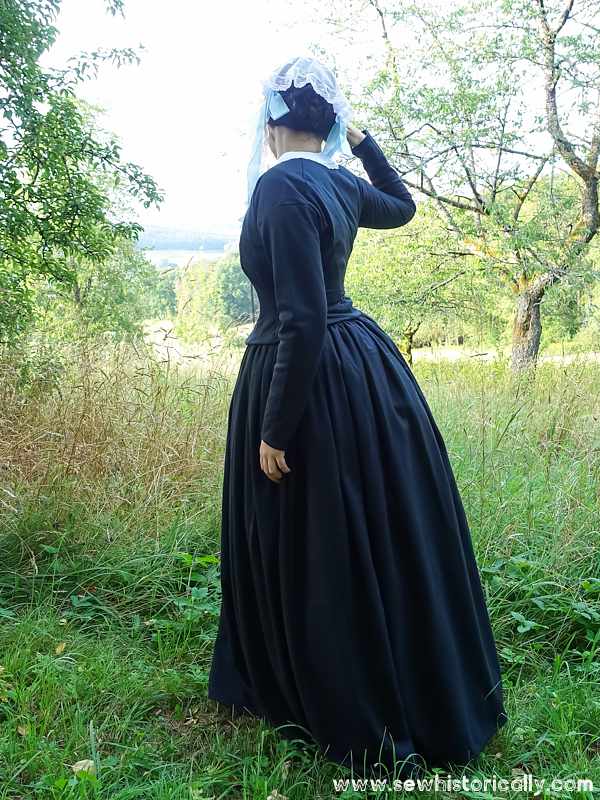
How Do You Store Your Historical Costumes?
I definitely don’t want moths holes in my antique clothes and my handmade historical costumes, such as this hand-sewn Victorian wool dress.
Related: Victorian Hand-Sewn Black Wool Dress
Therefore I always wash it after wearing – I pre-washed the wool fabric before making the dress to make sure that I can wash the dress in the washing machine later. I also store it together with cedar wood pieces and lavender sachets and put it away in a moth-proof plastic bag if I don’t plan to wear it for a longer time.
Carpet Care – How To Get Rid Of Carpet Beetles
‘Sometimes a heavy carpet, in a room seldom used, is not taken up at house-cleaning time. In this case lay a cloth along the edge of the carpet and pass slowly over it with a hot flat-iron. This will kill moths and their eggs. If moths are discovered in a carpet at a time when it is inconvenient to take it up, they may be killed in the same way.
A carpet, particularly if turned under at edges, should not be left down longer than one year, even if not much used. All moths work in the dark, hence clothing, furs or carpets exposed to the light are not in so much danger as when put away in the dark. […] To prevent moths under the carpets, grind black pepper coarsely, mix with camphor-gum, and strew thickly about the edges and wherever they are to be found.’ (Practical Housekeeping, 1887)
When To Put Away Winter Clothes
Moths and carpet beetles are especially active in late spring and summer. So to keep fabric pests away from woolen clothes, you should put them away not too late in the year.
Pack away ‘winter clothing, before the insidious miller claims them for its home’ (Three Meals A Day, 1902). ‘The best preventives against moths in household articles are to put them away before May or June where the moths cannot reach them when about to lay their eggs’ (The American Cyclopaedia, 1873).
‘Always clear out all closets and trunks early in the spring. […] The worms are torpid and do not work during the cold of the winter. Early in the spring they change into chrysalids, and again in about three weeks they transform into winged moths, when they fly about the house during the evening until May or June. Then they lay their eggs, always in dark places, and immediately after die. The eggs, which are too small to be detected with the naked eye, hatch out in about two weeks, and the young worms immediately proceed to work. Furs should not be worn late in the season.’ (Practical Housekeeping, 1887)
However, keep in mind that some fabric pests, such as museum nuisance beetles (Reesa vespulae), don’t even need males to reproduce. Once a female beetle is in a closet, it can start a colony and its offspring can stay there for years.
Spring Clean Your Closet
‘Wash and wipe floors and shelves’ (Three Meals A Day, 1902). ‘Always clear out all closets and trunks early in the spring. Wash with a sponge dipped in a mixture of ammonia and alcohol. Every thing the closets or trunks contain should be shaken and well aired.’ (Practical Housekeeping, 1887)
Natural Moths Repellents
Today, popular tips to prevent moths or to get rid of moths include storing lavender-filled sachets or cedar wood pieces between woolen clothing. Other strong natural smells are also often used, such as mint, cloves or woodruff. However, these natural moths repellents only kill young moths larvae but they don’t do anything against the eggs. Besides, lavender and cedar wood don’t keep away carpet beetles. So you can use these natural moths repellents in addition to other things but not alone.
It’s better to only use natural moths repellents. Keep in mind, that non-natural moths repellents, such as moth balls, contain chemicals that can be harmful to people and pets. You also shouldn’t use pheromone traps because they can attract moths from the outside and create a problem where there was none before.
In the Victorian era, pepper, camphor and turpentine were traditionally used to prevent moths damage to woolen clothes. To keep moths away ‘brush over their retreats with turpentine; […] strew camphor, black pepper, tobacco, or shavings of Russia leather under or among carpets, woollens, furs, or feathers’ (The American Cyclopaedia, 1873).
Herbs & Spices
‘In the country remote from drug-stores, many housekeepers use the dried leaves of sage, thyme, spearmint and other highly scented herbs. These are gathered after the housewife has laid in all she may require for cooking and medicinal purposes, are tied in bunches and dried, and then laid among the clothes in the large wooden chest; or a pole is laid from rafter to rafter, and the clothing is hung over this, and casings of calico or old cotton quilts are carefully pinned around each garment, the bunches of herbs being also pinned at intervals about the clothing.’ (Practical Housekeeping, 1887)
‘To prevent moths […] grind black pepper coarsely’ (Practical Housekeeping, 1887). ‘When packing away winter clothes, fill little cheesecloth bags with this mixture, and place among the clothes: 1 oz. each of powdered cloves, caraway seeds, nutmeg, mace, cinnamon, and tonca beans. To these add 6 oz. of orris root, (powdered).’ (Neighborhood Cook Book, 1924)
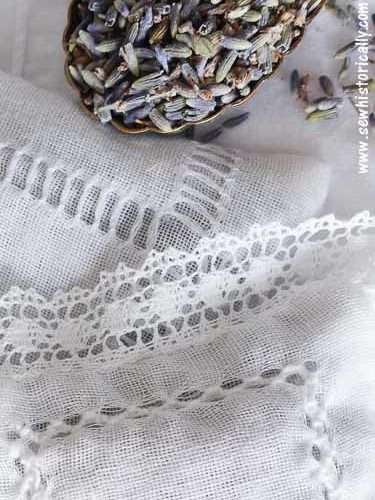
Related: How To Make Lavender Sachets – Like In The Edwardian Era
Powdered Chrysanthemums Aka Persian Powder
Persian powder is made from powdered Chrysanthemums and Tanacetums. ‘Pyrethrum carneum is the plant of which the celebrated Persian powder, for the destruction of insects, is prepared […] The parts used to make this powder are the dried flower heads, gathered when ripe, on fine days, and dried by exposure to the sun. […] When perfectly dried they are reduced to powder. The powder should be preserved in sealed vessels of glass.’ (Pacific Rural Press, 1876)
‘Dust Persian powder in all the cracks to prevent moths and other insects […] These rules apply to attic and closet.’ (Three Meals A Day, 1902)
Tobacco
‘Another, though more disagreeable mode of exterminating moths, is the smoke of tobacco, which infallibly kills them; but the articles thus fumigated should be afterwards exposed to the air, which speedily dissipates the peculiar smell of that narcotic herb.’ (Domestic Encyclopedia Or A Dictionary Of Facts, And Useful Knowledge Vol3, 1802)
Camphor
‘When packing away flannels and heavy winter clothing, camphor gum wrapped in pieces of tissue paper put among the goods is warranted to keep away moths.’ (A Bachelor’s Cupboard, 1906) Fold woolens ‘up with pulverized camphor’ (Practical Housekeeping, 1887). ‘Camphor gum is apt to turn furs a light color.’ (Three Meals A Day, 1902)
Turpentine
‘Many remedies have been devised, with a view to extirpate, or prevent the generation of moths: […] one of the most speedy remedies for their complete extermination, is the smell of turpentine: whether this diffusible oil be employed in a liquid state, by sprinkling it on woollen stuffs, or placing sheets of paper moistened with it between pieces of cloth; or merely by evaporating the oil in shallow vessels, placed contiguous to the articles infested with moths, its effects will be equally certain.’ (Domestic Encyclopedia Or A Dictionary Of Facts, And Useful Knowledge Vol3, 1802)
Up to the 1920s, paints and varnishes usually contained turpentine, so this might’ve also helped to keep moths and other fabric pests away!
Benzine
‘To prevent moths and other insects […] sprinkle benzine plentifully in the crevices. The odor will evaporate quickly. Be careful in handling it as it is very inflammable.’ (Three Meals A Day, 1902)
Cedar Wood
‘A cedar box is very nice’ (Three Meals A Day, 1902). ‘Cedar chests will effectually keep out moths, but few are so fortunate as to possess these.’ (Practical Housekeeping, 1887) Strew ‘cedar shavings […] upon each garment’ (Practical Housekeeping, 1887).
Light & Noise
‘All moths work in the dark, hence clothing, furs or carpets exposed to the light are not in so much danger as when put away in the dark.’ (Practical Housekeeping, 1887)
‘Set [the cedar chest] in closet in some part of the house which is frequented often during the warm weather, for the presence of any animated object is certain to disturb the moth.’ (Practical Housekeeping, 1887)
Use Wool To Keep Moths Away?!
It’s interesting that you can obviously use wool to keep moths away according to following historical source! However, you have to use raw wool: wool that is unwashed. If you want to try out this tip to keep moths away, you can usually buy raw wool from hand spinning suppliers.
‘It is remarkable, that moths never infest the fleeces on the backs of animals; nor even unwashed wool; so that they always abandon the place where such raw material is kept. Hence those persons, to whom the smell of turpentine is too offensive, may avail themselves of this circumstances, and place layers of undressed wool between pieces of cloth, or put small parcels in the corners of shelves and drawers containing drapery of that description. For the discovery of this curious and useful fact, we are indebted to M. Reaumur.’ (Domestic Encyclopedia Or A Dictionary Of Facts, And Useful Knowledge Vol3, 1802)
How To Get Rid Of Moths & Carpet Beetles
If you already have a moths or carpet beetle problem, the usual recommendation is to wash all clothes. But since this is an almost impossible task, you can also iron clothes instead of washing. Both, washing as well as ironing, effectively kills larvae and eggs of moths and beetles. However, freezing woolens doesn’t work to get rid of moths because moths and carpet beetles are equipped to survive even cold winters outside.
You also have to vacuum all cracks and crevices in floors and closets. And wash out the wardrobe or closet with soap, vinegar or alcohol before you put the clothes back. ‘Wash [closets] with a sponge dipped in a mixture of ammonia and alcohol.’ (Practical Housekeeping, 1887) Or better still store woolen clothes separately in plastic bags or a cedar box. Before you put away the washed woolen clothes, mend the holes with a patch or darning.
You can also use natural predators of clothes moths, such as trichogramma wasps. They are effective to get rid of moths, but they obviously do nothing against carpet beetles.
In A Nutshell: How To Get Rid Of Moths & Carpet Beetles
- wash or brush woolen clothes before storing
- iron clothes and carpets to kill moths and their eggs
- put away woolen clothes in spring
- store woolens in sealed plastic, fabric or paper bags
- use natural moths repellents, such as cedar, pepper, lavender, tobacco, turpentine or camphor
- regularly vacuum all cracks and crevices in floors and closets
- buy high quality wool broadcloth fabric and clothes
- to get rid of moths, buy trichogramma wasps
- don’t use pheromone traps
- freezing woolens doesn’t work
‘The best preventives against moths in household articles are to put them away before May or June where the moths cannot reach them when about to lay their eggs; to expose them to the air and sun for hours, after a good beating to dislodge any insects or eggs; to brush over their retreats with turpentine; to strew camphor, black pepper, tobacco, or shavings of Russia leather under or among carpets, woollens, furs, or feathers, when they are put away for the summer; the use of camphor wood or cedar trunks; corrosive sublimate washings, tobacco, and sulphur fumigations, and the action of heat and steam.’ (The American Cyclopaedia, 1873)
Please Pin It!
